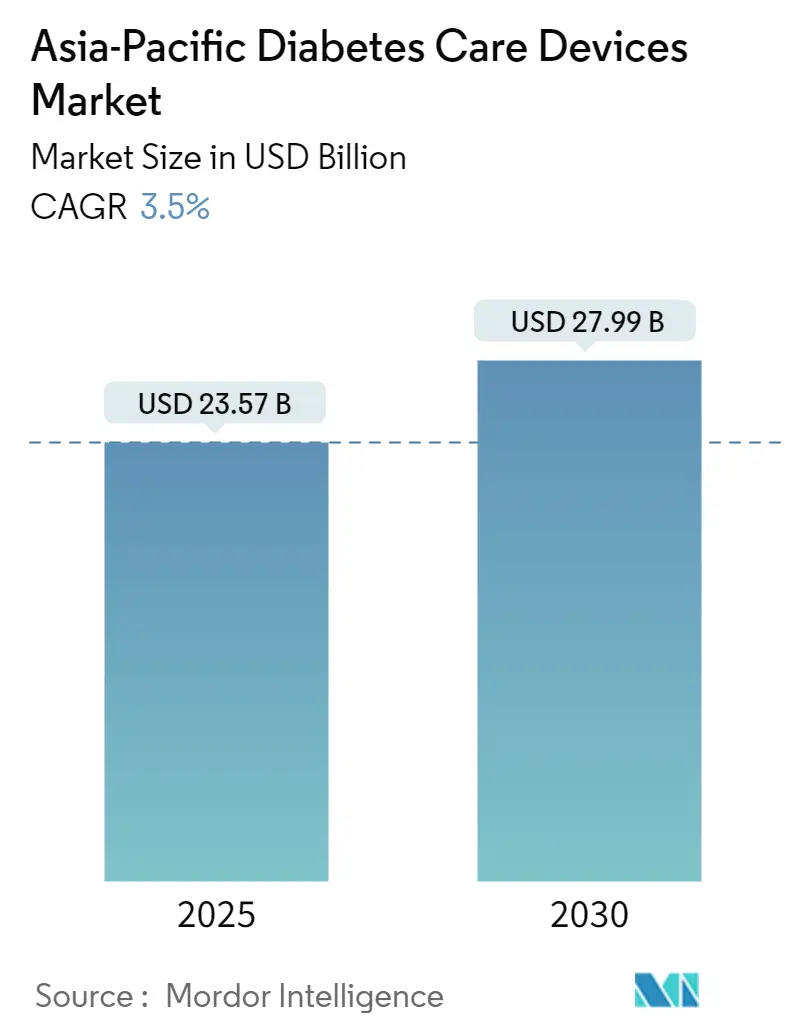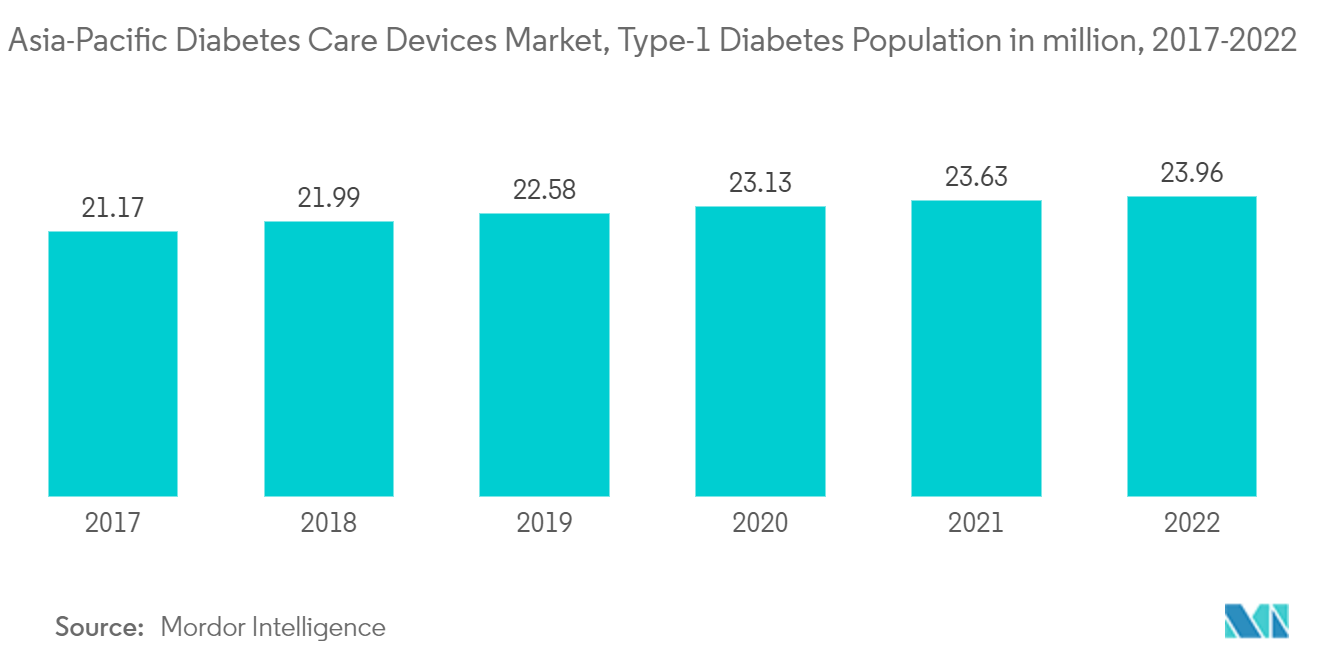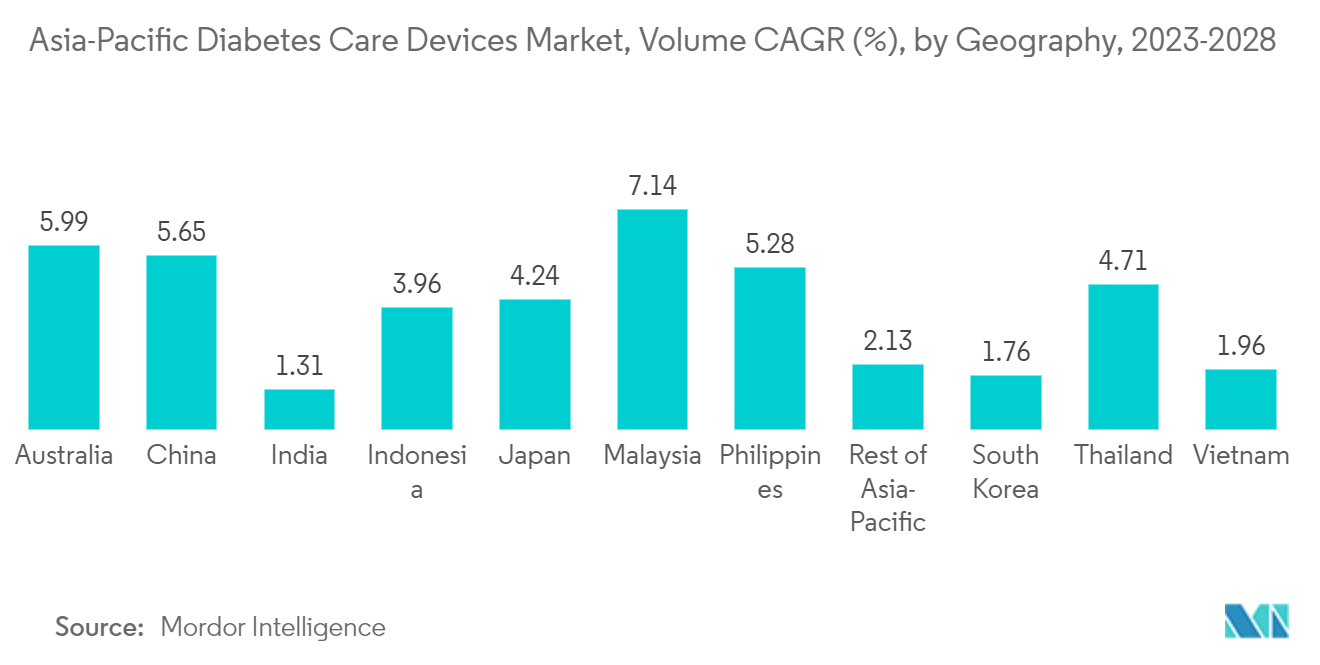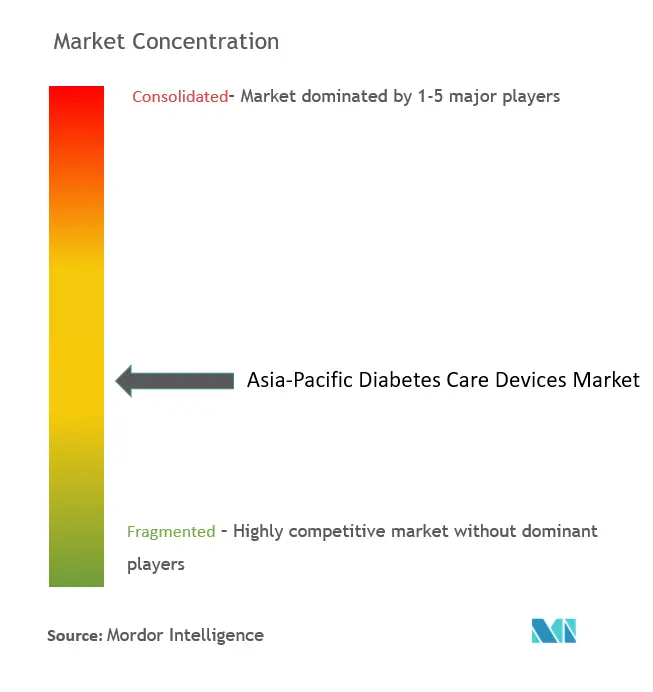
Asia-Pacific Diabetes Care Devices Market Analysis by Mordor Intelligence
The Asia-Pacific Diabetes Care Devices Market size is estimated at USD 23.57 billion in 2025, and is expected to reach USD 27.99 billion by 2030, at a CAGR of 3.5% during the forecast period (2025-2030).
The COVID-19 pandemic positively impacted the Asia-Pacific Diabetes Care Devices Market growth. Patients with diabetes, infected with COVID-19 may experience elevated blood glucose, abnormal glucose variability, and diabetic complications. The prevalence of diabetes in people with COVID-19 caused a significant increase in severity and mortality of COVID-19 in people with either type 1 (T1DM) or type 2 diabetes mellitus (T2DM), especially in association with poor glycemic control. While new-onset hyperglycemia and new-onset diabetes (both T1DM and T2DM) have been increasingly recognized in the context of COVID-19 and have been associated with worse outcomes. To avoid aggravation, a patient's blood glucose should be monitored regularly, which has underlined the importance of blood glucose monitoring devices. Pandemic emergency has created a rise in remote care from both patients and providers and removed many long-standing regulatory barriers.
According to International Diabetes Federation (IDF), 90 million adults (20-79) are living with diabetes in the IDF South-East Asia (SEA) Region in 2021. This figure is estimated to increase to 152 million by 2045 and 206 million adults (20-79) are living with diabetes in the IDF Western Pacific Region in 2021 which is estimated to increase to 260 million by 2045. The main diagnosis for diabetes patients is imbalances in blood glucose levels, which are not in compliance with the standard blood glucose levels. The general lab diagnostic tests can only help to diagnose the disease by physicians. Patients with more fluctuations in glucose levels need to get it checked every day. Patients administering insulin need to check their blood glucose levels frequently, adjust the doses of insulin, or change the medication, if necessary.
The rate of newly diagnosed Type 1 and Type 2 diabetes cases is seen to increase, mainly due to obesity, unhealthy diet, and physical inactivity. The rapidly increasing incidence and prevalence of diabetic patients and healthcare expenditure in developed countries are indications of the increasing usage of diabetic care products. Moreover, the increasing adoption of insulin delivery devices and the rising prevalence of diabetes are driving the market growth. Leading manufacturers are focusing on technological innovations and the development of advanced products to gain a substantial share of the market.
Therefore, owing to the aforementioned factors the studied market is anticipated to witness growth over the analysis period.
Asia-Pacific Diabetes Care Devices Market Trends and Insights
The continuous glucose monitoring segment is expected to witness a healthy growth rate over the forecast period
The continuous glucose monitoring segment is expected to witness a CAGR of 11.7% over the forecast period.
Continuous Glucose Monitoring Devices are automated glucose monitoring systems that consist of a small device that can be worn on the body and held on by an adhesive patch. The sensor part of the device contains a cannula inserted into the top layer of skin and uses interstitial fluid samples to check glucose levels. Sensors are connected to a transmitter that can send data wirelessly to a dedicated mobile receiving device or smartphone. Using CGMs for people with diabetes and their caregivers and communities is beneficial for managing their blood glucose and insulin levels to maintain their health outcomes. CGM makes it significantly easier to manage blood glucose levels by decreasing interruptions and allowing for better sleep. It also improves the mental health of patients or caregivers by reducing the overall mental load of managing diabetes, thereby enhancing the market prospects in the coming years.
Continuous glucose monitoring sensors use glucose oxidase to detect blood sugar levels. Glucose oxidase converts glucose to hydrogen peroxidase, which reacts with the platinum inside the sensor, producing an electrical signal to be communicated to the transmitter. Continuous glucose monitoring became a popular alternative to the portable finger-prick glucometers available in the market for the convenience of diabetic patients. Sensors are the most important part of continuous glucose monitoring devices. Technological advancements to improve the accuracy of the sensors are expected to drive segment growth during the forecast period. Various promising glucose-sensing technologies, from traditional electrochemical-based glucose sensors to novel optical and other electrical glucose sensors, are developed, positively impacting the market growth.
The market players are adopting various strategies and innovations to increase market share. For instance, In July 2021, Terumo Corporation announced the launch of the Dexcom G6 continuous glucose monitoring system in Japan. US-based Dexcom manufactures the Dexcom product, and Terumo holds the exclusive distribution agreement of Dexcom Products in Japan.
Thus, the abovementioned factors are expected to drive the segment growth over the forecast period.

Japan is expected to dominate the Asia-Pacific Diabetes Care Devices Market over the forecast period
Japan is expected to hold the highest market share in the Asia-Pacific Diabetes Care Devices Market over the forecast period.
Diabetes emerged as a global epidemic. Japan includes around 11 million people with diabetes, according to IDF 2021 data. While Type 1 diabetes is caused by an immune system malfunction, Type 2 diabetes is linked to leading a sedentary lifestyle, resulting in inherent resistance to insulin. Japan includes one of the largest elderly populations in the world, which is more susceptible to the onset of type 2 diabetes. As Japan's population continues to age, the prevalence of diabetes also increases. Monitoring and managing blood glucose levels are rising to avoid negative consequences, such as cardiovascular diseases, kidney disorders, etc.
Diabetes is identified as a healthcare priority by the Ministry of Health, Labour, and Welfare. The high prevalence of type 2 diabetes is associated with a significant economic burden. The costs of diabetes are increased in patients with co-morbidities such as hypertension and hyperlipidemia and in patients who develop complications. Costs increase with an increasing number of complications. Well-organized medical insurance systems cover all medical fees for diabetes mellitus, and people with diabetes can visit doctors freely in Japan. Also, insulin therapy by self-injection became legal and is covered by health insurance. The Japanese healthcare system comprises a few disease management programs conducted by the Japan Association for Diabetes Education and Care. Japan is one of the regional leaders in Asia-Pacific in terms of diabetic public health policies.
Such advantages helped the increased adoption of these products in the Japanese market.

Competitive Landscape
The Asia-Pacific Diabetes Care Devices Market is fragmented, with major companies like Abbott, LifeScan, F. Hoffmann-La Roche AG, and Novo Nordisk, and other generic players. They are strategically working to develop new technologies in diabetes care devices, which is likely to drive the market in the future.
Asia-Pacific Diabetes Care Devices Industry Leaders
F. Hoffmann-La Roche AG
Medtronic PLC
Abbott Diabetes Care
Novo Nordisk A/S
Eli Lilly and Company
- *Disclaimer: Major Players sorted in no particular order

Recent Industry Developments
- November 2023: Sibionics, a Chinese company, has recently received a CE Mark for its GS1 continuous glucose monitoring system (CGM). This innovative wearable device utilizes an under-the-skin sensor to accurately measure glucose levels in real-time. The collected data is then seamlessly transmitted to a connected handset or mobile phone. The GS1 CGM provides users with a remarkable 14-day continuous glucose monitoring experience, eliminating the need for frequent calibration. Additionally, it empowers users to effortlessly transmit their glucose data to monitoring devices or mobile apps, enabling them to generate comprehensive and insightful professional reports.
- August 2022: Ypsomed launched bolus delivery from the smartphone on the mylife YpsoPump via the mylife App. This new feature enables mylife YpsoPump users to deliver the bolus insulin conveniently and discreetly via their smartphone without interacting with the pump.
Asia-Pacific Diabetes Care Devices Market Report Scope
Diabetes care devices are the hardware, equipment, and software used by diabetes patients to regulate blood glucose levels, prevent diabetes complications, lessen the burden of diabetes, and enhance the quality of life. The Asia-Pacific Diabetes Care Devices Market is segmented into management devices (insulin pumps (insulin pump devices, insulin pump reservoirs, and infusion sets), insulin syringes, insulin cartridges in reusable pens, disposable insulin pens, and jet injectors), and monitoring devices (self-monitoring blood glucose (glucometer devices, blood glucose test strips, and lancets) and continuous glucose monitoring (sensors and durables)), by End-user (Hospital/Clinics, Home/Personal) and geography (Japan, South Korea, China, India, Australia, Vietnam, Malaysia, Indonesia, Philippines, Thailand, and rest of Asia-Pacific). The report offers the value (in USD) and volume (in units) for the above segments. Further, the report will cover a segment-wise breakdown (value and volume) for all the countries covered under the Table of Contents.
| Insulin Pump | Technology | Tethered Insulin Pump |
| Tubeless Insulin Pump | ||
| Component | Insulin Pump Device | |
| Insulin Pump Reservoir | ||
| Infusion Set | ||
| Insulin pens | Cartridges in Reusable Pens | |
| Insulin Disposable Pens | ||
| Insulin Syringes | ||
| Jet Injectors | ||
| Self-monitoring Blood Glucose | Glucometer Devices |
| Blood Glucose Test Strips | |
| Lancets | |
| Continuous Glucose Monitoring | Sensors |
| Durables (Receivers and Transmitters) |
| Hospital/Clinics |
| Home/Personal |
| Management Devices | Insulin Pump | Technology | Tethered Insulin Pump |
| Tubeless Insulin Pump | |||
| Component | Insulin Pump Device | ||
| Insulin Pump Reservoir | |||
| Infusion Set | |||
| Insulin pens | Cartridges in Reusable Pens | ||
| Insulin Disposable Pens | |||
| Insulin Syringes | |||
| Jet Injectors | |||
| Monitoring Devices | Self-monitoring Blood Glucose | Glucometer Devices | |
| Blood Glucose Test Strips | |||
| Lancets | |||
| Continuous Glucose Monitoring | Sensors | ||
| Durables (Receivers and Transmitters) | |||
| End User | Hospital/Clinics | ||
| Home/Personal | |||
Key Questions Answered in the Report
How big is the Asia-Pacific Diabetes Care Devices Market?
The Asia-Pacific Diabetes Care Devices Market size is expected to reach USD 23.57 billion in 2025 and grow at a CAGR of 3.5% to reach USD 27.99 billion by 2030.
What is the current Asia-Pacific Diabetes Care Devices Market size?
In 2025, the Asia-Pacific Diabetes Care Devices Market size is expected to reach USD 23.57 billion.
Who are the key players in Asia-Pacific Diabetes Care Devices Market?
F. Hoffmann-La Roche AG, Medtronic PLC, Abbott Diabetes Care, Novo Nordisk A/S and Eli Lilly and Company are the major companies operating in the Asia-Pacific Diabetes Care Devices Market.
What years does this Asia-Pacific Diabetes Care Devices Market cover, and what was the market size in 2024?
In 2024, the Asia-Pacific Diabetes Care Devices Market size was estimated at USD 22.75 billion. The report covers the Asia-Pacific Diabetes Care Devices Market historical market size for years: 2019, 2020, 2021, 2022, 2023 and 2024. The report also forecasts the Asia-Pacific Diabetes Care Devices Market size for years: 2025, 2026, 2027, 2028, 2029 and 2030.
Page last updated on:
Asia-Pacific Diabetes Care Devices Market Report
Statistics for the 2025 Asia-Pacific Diabetes Care Devices market share, size and revenue growth rate, created by Mordor Intelligence™ Industry Reports. Asia-Pacific Diabetes Care Devices analysis includes a market forecast outlook for 2025 to 2030 and historical overview. Get a sample of this industry analysis as a free report PDF download.



